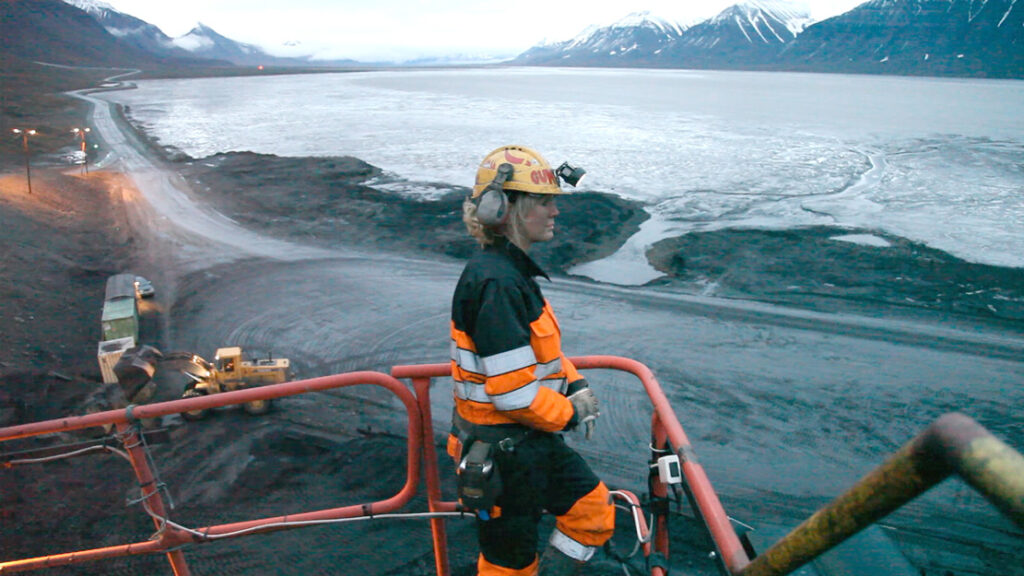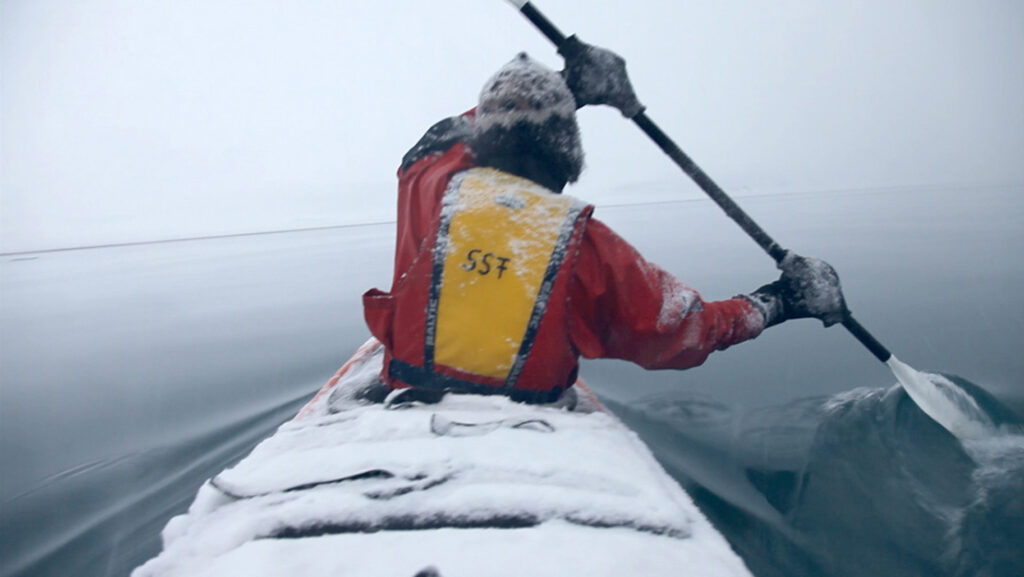
To inquire into the intricacies of a distant landscape, then, is to provoke thoughts about one’s own interior landscape, and the familiar landscapes of memory. The land urges us to come around to an understanding of ourselves.
—Barry Lopez, Arctic Dreams
In 2009 and 2010, Janet Biggs traveled to the Norwegian archipelago of Svalbard with a crew of artists and scientists aboard the Noorderlict, a two-masted schooner built in 1910. Using footage from these voyages, Biggs composed Warning Shot (2016), Brightness All Around (2011), and Fade to White (2010), three works that address grief, destruction, hope, and beauty of the Arctic landscape.
The subject of centuries of exploration, the Arctic was once thought so vast and inhospitable as to be immune to the effects of human enterprise. Today, scientists expect climate change to leave Arctic summers ice-free as early as the next decade. Svalbard, located halfway between Europe and the North Pole, sits at the epicenter of this transformation. Perhaps no other place that has figured so firmly in our imagination will disappear as quickly and with such overwhelming consequence, yet with so few people having witnessed it in person. Shown together in an exhibition that takes its name from the subtitle of Arctic Dreams, author Barry Lopez’s authoritative 1986 account of the human and natural history of the polar north, Warning Shot, Brightness All Around, and Fade to White are a clarion call for a heroic landscape that will completely vanish within our lifetimes.
Fade to White confronts a central theme of Janet Biggs’ work: exploring our struggle to maintain a sense of identity and individuality when challenged by environments that threaten us physically and emotionally. This concept is embedded in the video’s title, Fade to White, an editing technique used to evoke death or transcendence. Audun Tholfsen, a member of the Noorderlict’s crew, leaves the safety of the ship behind as he paddles his kayak toward a vanishing, featureless horizon—a literal fade to white. We feel a sense of imminent danger, recognizing how easy it would be to capsize or become disoriented, losing track of bearing and distance. Biggs also challenges the myth of the invincible polar hero and our endless fantasies of exploration and discovery. As in Brightness All Around, she intersperses footage from Svalbard with a vocal performance. Countertenor John Kelly’s mournful voice and slight physique parallel the fragility of the Arctic landscape and the catastrophic results of our hunger for adventure, territory, and profit.
Brightness All Around was filmed at the Sveagruva mine, one of Europe’s largest longwall coal mines. Trading on the tension between imagination and reality, the video challenges our expectations about the Arctic as a pristine wilderness. Linda Norberg, a female miner, begins her shift by descending miles beneath the earth’s surface. Besieged by deafening machinery, we follow her as she works in freezing temperatures and suffocating darkness. Musician Bill Coleman appears as a counterpoint to the mine’s almost extraterrestrial setting. Sexual, seductive, and aggressive, his presence feels every bit as menacing as Norberg’s surroundings. Singing lyrics drawn from survivors of near-death experiences—“I looked down and I saw myself / There was brightness all around me”—Coleman is a witness to our struggle to survive under the most demanding circumstances. While at first there seems to be little connection between Norberg and Coleman, his appearance is as much a shock to us as the Sveagruva mine, jarring impositions that shatter the mythology of a silent, uninhabited Arctic.
Warning Shot is an alarm and an elegy, memorializing a simple act performed in a remote landscape with no witnesses. Silhouetted against a halo of mountains, Janet Biggs enters the frame and fires a signal flare toward the horizon. Warning Shot is graceful, somber, and heartbreaking. Much like the artist’s own experience knowing that her distress signal would receive no response, we are reminded that no immanent rescue from environmental disaster is on the way. Shortly before his passing in December 2020, author Barry Lopez wrote, “An Era of Emergencies is bearing down on us.” Lopez and Biggs ask us to consider what—if anything—we are willing to do, where might we yield, if for no reason other than our own survival?

(Previous image) Janet Biggs, Warning Shot (video still), 2016. Single-channel HD video with sound, 16:9 format, running time 2:08.
Courtesy the artist and Cristin Tierney Gallery, New York

(above) Janet Biggs, Brightness All Around (video still), 2011. Single-channel HD video with sound, 16:9 format, running time 8:36. Courtesy the artist and Cristin Tierney Gallery, New York
About the Artist
Janet Biggs is a research-based, interdisciplinary artist known for her immersive work in video, film, and performance. Biggs’ work focuses on individuals in extreme landscapes or situations, navigating the territory between art, science and technology. Her work has taken her into areas of conflict and to Mars (as a member of crews at the Mars Desert Research Station and Mars Academy USA). Biggs has worked with institutions from NOAA to NASA and CERN. She has collaborated with high energy nuclear physicists, neuroscientists, Arctic explorers, aerospace engineers, astrophysicists, and a robot named Shimon. In 2020, Biggs sent a project up to the International Space Station as part of MIT Media Lab’s Space Exploration Initiative.

In addition to videos, her work includes multi-discipline performances, often including multiple large-scale videos, live musicians, athletes, and artificial intelligence.
Biggs is the recipient of numerous grants and awards including the 2018 John Simon Guggenheim Foundation fellowship, the Visionary Woman Award, the Electronic Media and Film Program at the New York State Council on the Arts Award, the Arctic Circle Fellowship/Residency, Art Matters, Inc., the Wexner Center Media Arts Program Residency, the Anonymous Was a Woman Award, and the NEA Fellowship Award.
Janet Biggs: Imagination and Desire in a Northern Landscape has been organized by the Barry Lopez Foundation for Art & Environment: barrylopezfoundation.org. Barry Lopez (1945-2020) was an American author and essayist, known for his writings on natural history and humankind’s relationship with the environment. Lopez and founding director Toby Jurovics launched the Barry Lopez Foundation for Art & Environment in 2020 because of their desire to help people visualize the environmental catastrophes we are facing with hope and understanding. The Foundation works with contemporary artists to organize exhibitions addressing climate change, biodiversity, habitat loss, and our changing relationship with the land in a time of environmental crisis.

Biggs. Fade to White (video still), 2010. Single-channel HD video with sound, 16:9 format, running time 12:28. Courtesy the artist and Cristin Tierney Gallery, New York
Sponsored by Visual Technologies.
